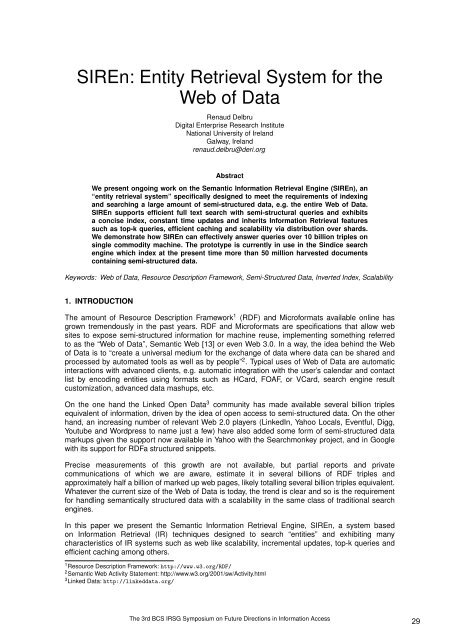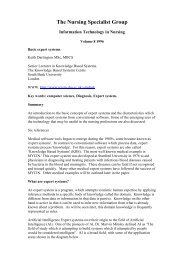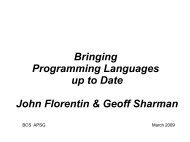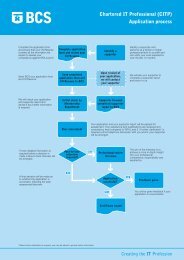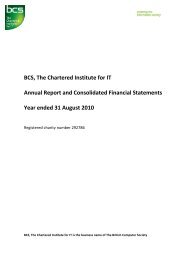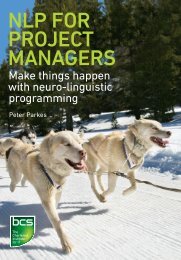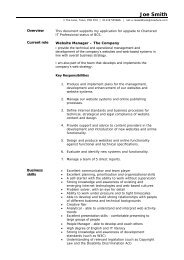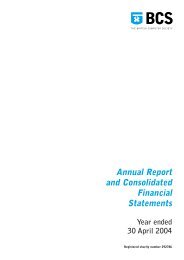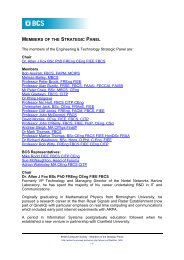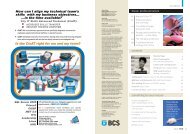SIREn: Entity Retrieval System for the Web of Data - BCS
SIREn: Entity Retrieval System for the Web of Data - BCS
SIREn: Entity Retrieval System for the Web of Data - BCS
- TAGS
- entity
- retrieval
- www.bcs.org
Create successful ePaper yourself
Turn your PDF publications into a flip-book with our unique Google optimized e-Paper software.
<strong>SIREn</strong>: <strong>Entity</strong> <strong>Retrieval</strong> <strong>System</strong> <strong>for</strong> <strong>the</strong><br />
<strong>Web</strong> <strong>of</strong> <strong>Data</strong><br />
Renaud Delbru<br />
Digital Enterprise Research Institute<br />
National University <strong>of</strong> Ireland<br />
Galway, Ireland<br />
renaud.delbru@deri.org<br />
Abstract<br />
We present ongoing work on <strong>the</strong> Semantic In<strong>for</strong>mation <strong>Retrieval</strong> Engine (<strong>SIREn</strong>), an<br />
“entity retrieval system” specifically designed to meet <strong>the</strong> requirements <strong>of</strong> indexing<br />
and searching a large amount <strong>of</strong> semi-structured data, e.g. <strong>the</strong> entire <strong>Web</strong> <strong>of</strong> <strong>Data</strong>.<br />
<strong>SIREn</strong> supports efficient full text search with semi-structural queries and exhibits<br />
a concise index, constant time updates and inherits In<strong>for</strong>mation <strong>Retrieval</strong> features<br />
such as top-k queries, efficient caching and scalability via distribution over shards.<br />
We demonstrate how <strong>SIREn</strong> can effectively answer queries over 10 billion triples on<br />
single commodity machine. The prototype is currently in use in <strong>the</strong> Sindice search<br />
engine which index at <strong>the</strong> present time more than 50 million harvested documents<br />
containing semi-structured data.<br />
Keywords: <strong>Web</strong> <strong>of</strong> <strong>Data</strong>, Resource Description Framework, Semi-Structured <strong>Data</strong>, Inverted Index, Scalability<br />
1. INTRODUCTION<br />
The amount <strong>of</strong> Resource Description Framework 1 (RDF) and Micro<strong>for</strong>mats available online has<br />
grown tremendously in <strong>the</strong> past years. RDF and Micro<strong>for</strong>mats are specifications that allow web<br />
sites to expose semi-structured in<strong>for</strong>mation <strong>for</strong> machine reuse, implementing something referred<br />
to as <strong>the</strong> “<strong>Web</strong> <strong>of</strong> <strong>Data</strong>”, Semantic <strong>Web</strong> [13] or even <strong>Web</strong> 3.0. In a way, <strong>the</strong> idea behind <strong>the</strong> <strong>Web</strong><br />
<strong>of</strong> <strong>Data</strong> is to “create a universal medium <strong>for</strong> <strong>the</strong> exchange <strong>of</strong> data where data can be shared and<br />
processed by automated tools as well as by people” 2 . Typical uses <strong>of</strong> <strong>Web</strong> <strong>of</strong> <strong>Data</strong> are automatic<br />
interactions with advanced clients, e.g. automatic integration with <strong>the</strong> user’s calendar and contact<br />
list by encoding entities using <strong>for</strong>mats such as HCard, FOAF, or VCard, search engine result<br />
customization, advanced data mashups, etc.<br />
On <strong>the</strong> one hand <strong>the</strong> Linked Open <strong>Data</strong> 3 community has made available several billion triples<br />
equivalent <strong>of</strong> in<strong>for</strong>mation, driven by <strong>the</strong> idea <strong>of</strong> open access to semi-structured data. On <strong>the</strong> o<strong>the</strong>r<br />
hand, an increasing number <strong>of</strong> relevant <strong>Web</strong> 2.0 players (LinkedIn, Yahoo Locals, Eventful, Digg,<br />
Youtube and Wordpress to name just a few) have also added some <strong>for</strong>m <strong>of</strong> semi-structured data<br />
markups given <strong>the</strong> support now available in Yahoo with <strong>the</strong> Searchmonkey project, and in Google<br />
with its support <strong>for</strong> RDFa structured snippets.<br />
Precise measurements <strong>of</strong> this growth are not available, but partial reports and private<br />
communications <strong>of</strong> which we are aware, estimate it in several billions <strong>of</strong> RDF triples and<br />
approximately half a billion <strong>of</strong> marked up web pages, likely totalling several billion triples equivalent.<br />
Whatever <strong>the</strong> current size <strong>of</strong> <strong>the</strong> <strong>Web</strong> <strong>of</strong> <strong>Data</strong> is today, <strong>the</strong> trend is clear and so is <strong>the</strong> requirement<br />
<strong>for</strong> handling semantically structured data with a scalability in <strong>the</strong> same class <strong>of</strong> traditional search<br />
engines.<br />
In this paper we present <strong>the</strong> Semantic In<strong>for</strong>mation <strong>Retrieval</strong> Engine, <strong>SIREn</strong>, a system based<br />
on In<strong>for</strong>mation <strong>Retrieval</strong> (IR) techniques designed to search “entities” and exhibiting many<br />
characteristics <strong>of</strong> IR systems such as web like scalability, incremental updates, top-k queries and<br />
efficient caching among o<strong>the</strong>rs.<br />
1 Resource Description Framework: http://www.w3.org/RDF/<br />
2 Semantic <strong>Web</strong> Activity Statement: http://www.w3.org/2001/sw/Activity.html<br />
3 Linked <strong>Data</strong>: http://linkeddata.org/<br />
The 3rd <strong>BCS</strong> IRSG Symposium on Future Directions in In<strong>for</strong>mation Access<br />
29
1.1. <strong>Web</strong> <strong>of</strong> <strong>Data</strong>: Preliminaries<br />
<strong>SIREn</strong>: <strong>Entity</strong> <strong>Retrieval</strong> <strong>System</strong> <strong>for</strong> <strong>the</strong> <strong>Web</strong> <strong>of</strong> <strong>Data</strong><br />
The <strong>Web</strong> <strong>of</strong> <strong>Data</strong> is based on <strong>the</strong> RDF data model that provides <strong>the</strong> functionality <strong>of</strong> making<br />
machine understandable statement about any resources. An RDF statement is expressed as a<br />
triple (s, p, o) consisting <strong>of</strong> a subject, a predicate, and an object and asserts that a subject<br />
has a property (predicate) with some value (object). Given three infinite sets U, B and L called<br />
respectively URI references, blank nodes and literals, an RDF statement (s, p, o) is an element <strong>of</strong><br />
(U ∪ B) × U × (U ∪ B ∪ L). An RDF statement can be interpreted as a labelled edge where both <strong>the</strong><br />
subject and object are <strong>the</strong> nodes and <strong>the</strong> predicate is a labelled edge connecting <strong>the</strong> two nodes.<br />
While RDF triples are a seemingly simple concept, <strong>the</strong> true power <strong>of</strong> RDF lies in <strong>the</strong> fact that <strong>the</strong>se<br />
triples are combined to <strong>for</strong>m a labelled, directed multi-graph, as depicted in Fig. 1a.<br />
The <strong>Web</strong> <strong>of</strong> <strong>Data</strong> is composed <strong>of</strong> many interconnected RDF graphs, or datasets, each one nameable<br />
by an URI. These named graphs [5] are composed <strong>of</strong> quads. A quad q is a statement (s, p, o, c) with<br />
a fourth element c ∈ U called “context” <strong>for</strong> naming <strong>the</strong> RDF dataset in order to keep <strong>the</strong> provenance<br />
<strong>of</strong> <strong>the</strong> RDF data.<br />
1.2. <strong>Web</strong> <strong>of</strong> <strong>Data</strong>: Requirements <strong>for</strong> <strong>SIREn</strong><br />
<strong>SIREn</strong> has been conceived to index <strong>the</strong> entire “<strong>Web</strong> <strong>of</strong> <strong>Data</strong>”. The requirements have <strong>the</strong>re<strong>for</strong>e<br />
been:<br />
1. Support <strong>for</strong> <strong>the</strong> multiple <strong>for</strong>mats which are used on <strong>the</strong> <strong>Web</strong> <strong>of</strong> <strong>Data</strong>;<br />
2. Support <strong>for</strong> entity centric search;<br />
3. Support <strong>for</strong> context (provenance) <strong>of</strong> in<strong>for</strong>mation: entity descriptions are given in <strong>the</strong> context <strong>of</strong><br />
a website or dataset;<br />
4. Support <strong>for</strong> semi-structural full text search, top-k query, scalability via shard over clusters <strong>of</strong><br />
commodity machines, efficient caching strategy and real-time dynamic index maintenance.<br />
With respect to point 1, <strong>the</strong> two <strong>for</strong>mats which enable <strong>the</strong> annotations <strong>of</strong> entities on web pages<br />
are Micro<strong>for</strong>mats and RDF. At knowledge representation level, <strong>the</strong> main difference between<br />
Micro<strong>for</strong>mats and RDF is that <strong>the</strong> <strong>for</strong>mer can be seen as a frame model while <strong>the</strong> latter has a graph<br />
based data model. While <strong>the</strong>se are major conceptual differences, it is easy to see that <strong>the</strong> RDF<br />
model can be used effectively to map Micro<strong>for</strong>mats 4 . Under <strong>the</strong>se conditions, we have developed<br />
<strong>SIREn</strong> to cover <strong>the</strong> RDF model knowing that this would cover Micro<strong>for</strong>mats and likely o<strong>the</strong>r <strong>for</strong>ms <strong>of</strong><br />
web metadata.<br />
With respect to point 2 and 3, <strong>the</strong> main use case <strong>for</strong> which <strong>SIREn</strong> is developed is entity search:<br />
given a description <strong>of</strong> an entity, i.e. a star-shaped queries such as <strong>the</strong> one in Fig. 1b, locate <strong>the</strong><br />
most suitable entities and datasets. This means that, in terms <strong>of</strong> granularity, <strong>the</strong> search needs to<br />
move from “page” (as per normal web search) to a “dataset-entity”. The Fig. 1a shows an RDF<br />
graph and how it can be split into three entities renaud, giovanni and DERI. Each entity description<br />
<strong>for</strong>ms a sub-graph containing <strong>the</strong> incoming and outgoing relations <strong>of</strong> <strong>the</strong> entity node.<br />
Finally, we will see in Sect. 2 that <strong>the</strong> <strong>SIREn</strong> model enables dataset-entity centric search while<br />
leveraging well known IR techniques to address <strong>the</strong> point 4.<br />
1.3. Approaches <strong>for</strong> <strong>Entity</strong> <strong>Retrieval</strong><br />
Given an query, an <strong>Entity</strong> <strong>Retrieval</strong> <strong>System</strong> (ERS) helps to locate and retrieve a list <strong>of</strong> relevant<br />
entities. An ERS should allow “imprecise” or “fuzzy” queries and rank <strong>the</strong> results based on <strong>the</strong>ir<br />
relevance to <strong>the</strong> queries. The entity retrieval task is selection-oriented, <strong>the</strong> aim is to select potential<br />
relevant entities (e.g. <strong>the</strong> top-k most relevant ones) from a large entity collection. Two main<br />
approaches have been taken <strong>for</strong> entity retrieval, DBMS based and IR based.<br />
1.3.1. DBMS based approaches<br />
Typically, entities described in RDF data are handled using systems referred to as “triplestores” or<br />
“quadstores” and that usually employ techniques coming from <strong>the</strong> DBMS world. Some <strong>of</strong> <strong>the</strong>se are<br />
4 Any23: http://code.google.com/p/any23/<br />
The 3rd <strong>BCS</strong> IRSG Symposium on Future Directions in In<strong>for</strong>mation Access<br />
30
<strong>SIREn</strong>: <strong>Entity</strong> <strong>Retrieval</strong> <strong>System</strong> <strong>for</strong> <strong>the</strong> <strong>Web</strong> <strong>of</strong> <strong>Data</strong><br />
(a) Visual representation <strong>of</strong> an RDF graph. The RDF<br />
graph is divided (dashed lines) into three entities<br />
identified by <strong>the</strong> node renaud, giovanni and DERI<br />
(b) Star-shaped query matching <strong>the</strong> entity<br />
renaud where ? is <strong>the</strong> bound variable and<br />
⋆ a wildcard<br />
FIGURE 1: In <strong>the</strong>se graphs, oval nodes represent resources and rectangular ones represent literals.<br />
For space consideration, URIs have been replaced by <strong>the</strong>ir local names.<br />
built on top <strong>of</strong> existing DBMS such as Virtuoso 5 or column stores [1] while o<strong>the</strong>rs are purposely built<br />
to handle RDF, e.g. [7, 16, 11].<br />
These triplestores are built to manage large amounts <strong>of</strong> RDF triples or quads and <strong>the</strong>y do so<br />
employing multiples indices (generally b-trees) <strong>for</strong> covering all kind <strong>of</strong> access patterns <strong>of</strong> <strong>the</strong> <strong>for</strong>m<br />
(s,p,o,c). As <strong>for</strong> DBMS, <strong>the</strong> main goal <strong>of</strong> <strong>the</strong>se systems is answering possibly complex queries,<br />
e.g. those posed using <strong>the</strong> SPARQL query language 6 . This task is a superset <strong>of</strong> entity retrieval<br />
as we defined it, and can be seen as trans<strong>for</strong>mation-oriented since DBMS provide functionality to<br />
select entities but also to trans<strong>for</strong>m <strong>the</strong> result set (e.g. create a new RDF graph). This comes at <strong>the</strong><br />
cost <strong>of</strong> maintaining complex data structures and index duplication. Also <strong>the</strong>y usually do not support<br />
“imprecise” and top-k queries, but instead return all results that precisely match <strong>the</strong> query (similarly<br />
to SQL query in relational databases).<br />
1.3.2. In<strong>for</strong>mation <strong>Retrieval</strong> <strong>for</strong> Semi-Structured <strong>Data</strong> and RDF<br />
In<strong>for</strong>mation <strong>Retrieval</strong> (IR) techniques [2, 9] <strong>of</strong>fer tools to overcome such limitations and have been<br />
shown by modern search engines to scale to <strong>the</strong> size <strong>of</strong> <strong>the</strong> web. For <strong>the</strong>se reasons, recent<br />
systems [17, 3] have started to explore IR also <strong>for</strong> searching RDF data.<br />
<strong>SIREn</strong> continues on this trend <strong>of</strong> research by proposing a variant <strong>of</strong> a word level inverted index<br />
based on a node-labelled tree data structure. Such technique is coming from IR <strong>for</strong> semi-structured<br />
text [10] such as XML document. Node labelling schemes [14] have been developed to optimise<br />
retrieval <strong>of</strong> XML search engines since <strong>the</strong>y provide an efficient way to encode and query <strong>the</strong> tree<br />
structure <strong>of</strong> an XML document. In this paper, we propose to adapt such technique to <strong>the</strong> RDF data<br />
model.<br />
The paper is organized as follows: we first present <strong>the</strong> index data model in Sect. 2.1 and <strong>the</strong><br />
associated query model in Sect. 2.2. We report in Sect. 2.3 a short overview <strong>of</strong> <strong>the</strong> results <strong>of</strong><br />
<strong>the</strong> current scalability evaluation.<br />
2. THE SIREN MODEL<br />
An entity description is a set <strong>of</strong> triples having one common node and can be depicted as a starshaped<br />
graph. The simplest semi-structured indexing method is to represent an entity as a set<br />
<strong>of</strong> attribute-value pairs using field-based approach [8]. With field-based indexing, index terms are<br />
constructed by concatenating <strong>the</strong> field name with <strong>the</strong> terms from <strong>the</strong> content <strong>of</strong> this field. For<br />
example, if a publication has a field title, author and abstract, <strong>the</strong> index terms <strong>for</strong> <strong>the</strong> author field will<br />
be represented as author:renaud and author:delbru.<br />
While this technique is widely used, it has strong limitations when dealing with large amount <strong>of</strong><br />
heterogeneous semi-structured data:<br />
5 Virtuoso: http://virtuoso.openlinksw.com/<br />
6 SPARQL: http://www.w3.org/TR/rdf-sparql-query/<br />
The 3rd <strong>BCS</strong> IRSG Symposium on Future Directions in In<strong>for</strong>mation Access<br />
31
(a) Conceptual representation <strong>of</strong> <strong>the</strong> data<br />
tree model <strong>of</strong> <strong>the</strong> index<br />
<strong>SIREn</strong>: <strong>Entity</strong> <strong>Retrieval</strong> <strong>System</strong> <strong>for</strong> <strong>the</strong> <strong>Web</strong> <strong>of</strong> <strong>Data</strong><br />
(b) Node-labelled data tree <strong>of</strong> <strong>the</strong> example dataset using Dewey’s encoding<br />
FIGURE 2: The <strong>SIREn</strong> data model<br />
1. It is very inefficient to search across all <strong>the</strong> fields. A single query term will be expanded into a<br />
disjunction <strong>of</strong> n index terms with n <strong>the</strong> number <strong>of</strong> different fields.<br />
2. The lexicon becomes prohibitly large, and <strong>the</strong>re<strong>for</strong>e index term lookups becomes expensive.<br />
Many identical terms can appear in various fields, but will be considered as different terms by<br />
<strong>the</strong> system. For example, if m terms appear in n fields, it will produce m ∗ n index terms.<br />
3. Multi-valued fields cannot be handled properly. At query time, we cannot differentiate if an<br />
index term belongs to <strong>the</strong> first or second value <strong>of</strong> a field. This causes false-positive when<br />
using term conjunction. For example, if a publication has two authors, e.g. Renaud Delbru<br />
and Giovanni Tumarrello, <strong>the</strong>n <strong>the</strong> query author:renaud AND author:tumarrello will return a<br />
match which is not <strong>the</strong> expected behaviour.<br />
In order to overcome <strong>the</strong>se limitations, we designed an inverted index based on a tree-structured<br />
data model that enables versatile star-shaped querying while enjoying efficient use <strong>of</strong> disk space,<br />
effective compression, fast dynamic updates and sub-linear query processing.<br />
2.1. <strong>SIREn</strong> <strong>Data</strong> Model<br />
<strong>SIREn</strong>, similarly to XML in<strong>for</strong>mation retrieval engine, adopts a tree data structure and orderings <strong>of</strong><br />
tree nodes to model datasets, entities and <strong>the</strong>ir RDF descriptions. The data tree model is pictured in<br />
Fig. 2a. This model has a hierarchical structure with four different kind <strong>of</strong> nodes: context (dataset),<br />
subject (entity), predicate and object. Each node can refer to one or more terms. In case <strong>of</strong> RDF,<br />
a term is not necessarily a word (as in part <strong>of</strong> an RDF Literal), but can be an URI or a local blank<br />
node identifier.<br />
Inverted index based on tree data structure enables to efficiently establish relationships between<br />
tree nodes. There are two main types <strong>of</strong> relations: Parent-Child (PC) and Ancestor-Descendant<br />
(AC). To support this set <strong>of</strong> relations, <strong>the</strong> requirement is to assign unique identifiers (node labels)<br />
that encodes relationships between <strong>the</strong> tree nodes. Several node labelling schemes have been<br />
developed and <strong>the</strong> reader can refer to [14] <strong>for</strong> an overview <strong>of</strong> <strong>the</strong>m. In <strong>the</strong> rest <strong>of</strong> <strong>the</strong> paper, we will<br />
use a simple prefix scheme, <strong>the</strong> Dewey Order encoding [4], but <strong>the</strong> model is not restricted to <strong>the</strong><br />
Dewey scheme and ano<strong>the</strong>r scheme (e.g. interval-based) could be used instead.<br />
Using this labelling scheme, structural relationships between elements can be determined efficiently.<br />
An element u is an ancestor <strong>of</strong> an element v if label(u) is a prefix <strong>of</strong> label(v). Fig. 2b presents a data<br />
tree where nodes have been labelled using Dewey’s encoding. Given <strong>the</strong> label 〈1.2.1.1〉 <strong>for</strong> <strong>the</strong> term<br />
Organisation, we can efficiently find that its parent is <strong>the</strong> predicate rdf:type, labelled with 〈1.2.1〉.<br />
The data tree structure with PC and AC relations covers <strong>the</strong> quad relations CSPO (outgoing<br />
relations) and COPS (incoming relations). Incoming relations are symbolised by a predicate node<br />
with a − 1 tag in Fig. 2b. The tree data structure is not limited to quad relations, and could in <strong>the</strong>ory<br />
be used to encode longer paths such as 2-hop outgoing and incoming relations.<br />
The 3rd <strong>BCS</strong> IRSG Symposium on Future Directions in In<strong>for</strong>mation Access<br />
32
2.2. <strong>SIREn</strong> Query Model<br />
<strong>SIREn</strong>: <strong>Entity</strong> <strong>Retrieval</strong> <strong>System</strong> <strong>for</strong> <strong>the</strong> <strong>Web</strong> <strong>of</strong> <strong>Data</strong><br />
Since RDF is semi-structured data, we expect three types <strong>of</strong> queries: 1. full-text search (keyword<br />
based), 2. semi-structural queries (complex queries specified in a star-shaped structure), 3. or a<br />
combination <strong>of</strong> <strong>the</strong> two (where full-text search can be used on any part <strong>of</strong> <strong>the</strong> star-shaped query).<br />
We present in this section a set <strong>of</strong> query operators over <strong>the</strong> content and structure <strong>of</strong> <strong>the</strong> data tree<br />
that cover <strong>the</strong> three types <strong>of</strong> queries.<br />
2.2.1. <strong>SIREn</strong> Operators<br />
Content operators The content query operators are <strong>the</strong> only ones that access <strong>the</strong> content <strong>of</strong> a<br />
node, and are orthogonal to <strong>the</strong> structure operators. They include extended boolean operations such<br />
as boolean operators (intersection, union, difference), proximity operators (phrase, near, be<strong>for</strong>e,<br />
after, etc.) and fuzzy or wildcard operators.<br />
These operations allow to express complex keyword queries <strong>for</strong> each node <strong>of</strong> <strong>the</strong> tree. Interestingly,<br />
it is possibly to apply <strong>the</strong>se operators not only on literals, but also on URIs (subject, predicate and<br />
object), if URIs are normalized (i.e. tokenized). For example one could just use an RDF local name,<br />
e.g. name, to match foaf:name ignoring <strong>the</strong> namespace.<br />
Structure operators In <strong>the</strong> following, we define a set <strong>of</strong> operations over <strong>the</strong> structure <strong>of</strong> <strong>the</strong> data<br />
tree. Thanks to <strong>the</strong>se operations, we are able to search content to limited tree nodes, to query node<br />
relationships and to retrieve paths <strong>of</strong> nodes matching a given pattern. Joins over paths are possible<br />
using set operators, enabling <strong>the</strong> computation <strong>of</strong> entities and datasets matching a given star-shaped<br />
query.<br />
Ancestor-Descendant: A//D A node A is <strong>the</strong> ancestor <strong>of</strong> a node D if it exists a path between A<br />
and D. For example, <strong>the</strong> SPARQL query in Listing 1, line 1, can be interpreted as an Ancestor-<br />
Descendant operator, line 2, and will return <strong>the</strong> path 〈1.2.2.1〉.<br />
Parent-Child: P/C A node P is <strong>the</strong> parent <strong>of</strong> a node C if P is an ancestor <strong>of</strong> C and C is exactly one<br />
level above P. For example, <strong>the</strong> SPARQL query in Listing 1, line 3, can be translated into a<br />
Parent-Child operator, line 4, and will return <strong>the</strong> path 〈1.1.1.1〉.<br />
Set manipulation operators These operators allow to manipulate nodes <strong>of</strong> <strong>the</strong> tree (context,<br />
subject, predicate and object) as sets, implementing union (∪), difference (\) and intersection<br />
(∩). For example in Listing 1, <strong>the</strong> SPARQL query, line 5, can be interpreted as two Parent-Child<br />
operators with <strong>the</strong> intersection operator (AND), line 6.<br />
In addition, operators can be nested to express longer path as shown in Listing 1, line 7 and 9.<br />
However, <strong>the</strong> later is possible only if deeper trees have been indexed, i.e. 2-hop outgoing and<br />
incoming relations <strong>of</strong> an entity.<br />
Listing 1: SPARQL queries and <strong>the</strong>ir <strong>SIREn</strong> interpretation<br />
1 SELECT ?g WHERE { GRAPH ?g { deri ?p renaud }}<br />
2 deri // renaud<br />
3 SELECT ?g ?s WHERE { GRAPH ?g { ?s name "Renaud Delbru" }}<br />
4 name / "Renaud Delbru"<br />
5 SELECT ?g ?o WHERE { GRAPH ?g { giovanni knows ?o . deri employerOf ?o . }}<br />
6 knows^-1 / giovanni AND employerOf^-1 / deri<br />
7 SELECT ?s WHERE { GRAPH { ?s knows renaud }}<br />
8 renaud.delbru.fr // knows / renaud<br />
9 SELECT ?g ?s WHERE { GRAPH ?g { ?s employerOf ?o . ?o name "renaud" . }}<br />
10 employerOf // name / "renaud"<br />
2.2.2. SPARQL Interpretation<br />
In this section we discuss <strong>the</strong> extension by which, given <strong>the</strong> above discussed operators, it is possible<br />
to support a subset <strong>of</strong> <strong>the</strong> standard SPARQL query language.<br />
By indexing outgoing relations alone, we can show to cover <strong>the</strong> quad access patterns listed in<br />
Table 1. A quad lookup is per<strong>for</strong>med using <strong>the</strong> tuple operators. Join operations over <strong>the</strong>se patterns<br />
The 3rd <strong>BCS</strong> IRSG Symposium on Future Directions in In<strong>for</strong>mation Access<br />
33
<strong>SIREn</strong>: <strong>Entity</strong> <strong>Retrieval</strong> <strong>System</strong> <strong>for</strong> <strong>the</strong> <strong>Web</strong> <strong>of</strong> <strong>Data</strong><br />
SPOC POCS OCSP CPSO CSPO OSPC<br />
(?,*,*,?) (?,p,*,?) (?,*,o,?) (?,*,*,c) (s,*,*,c) (s,*,o,?)<br />
p o c c/s s//o<br />
(s,*,*,?) (?,p,o,?) (?,*,o,c) (?,p,*,c) (s,p,*,c)<br />
s p/o c//o c//p c/s/p<br />
(s,p,*,?) (?,p,o,c) (s,*,o,c)<br />
s/p c//p/o c/s//o<br />
(s,p,o,?)<br />
s/p/o<br />
TABLE 1: Quad patterns covered by outgoing relations and <strong>the</strong>ir interpretation with <strong>the</strong> <strong>SIREn</strong><br />
operators. The ? stands <strong>for</strong> <strong>the</strong> elements that are retrieved and <strong>the</strong> * stands <strong>for</strong> a wildcard element.<br />
Q1 Q2 Q3 Q4 Q5 Q6 Q7 Q8<br />
Time (s) 0.75 1.3 1.4 0.5 1.5 1.6 4 0.35<br />
Hits 7552 9344 3.5M 57K 448 8.2M 20.7M 672<br />
TABLE 2: Querying time in seconds and number <strong>of</strong> hits <strong>for</strong> <strong>the</strong> 10 billion triples benchmark<br />
are also feasible. Intersection, union and difference between two or more quad patterns can be<br />
achieved efficiently using set manipulations over tree nodes.<br />
The covered quad patterns are a subset <strong>of</strong> <strong>the</strong> quad patterns covered by conventional RDF data<br />
management systems [6]. In fact, <strong>the</strong>y give <strong>the</strong> ability to retrieve in<strong>for</strong>mation about variables that are<br />
restricted to be at <strong>the</strong> subject, object or context position.<br />
It is important to underline however that we are restricting <strong>the</strong> search <strong>of</strong> an entity inside a dataset, i.e.<br />
<strong>SIREn</strong> does not allow <strong>the</strong> use <strong>of</strong> joins over different contexts, and <strong>the</strong> intersection <strong>of</strong> quad patterns<br />
within an entity, i.e. <strong>SIREn</strong> does not allow <strong>the</strong> use <strong>of</strong> chains <strong>of</strong> joins among multiples entities. This<br />
limits <strong>the</strong> query expressiveness to a star-shaped query, e.g. in Fig. 1b.<br />
2.3. Evaluation<br />
We finally report some per<strong>for</strong>mance and scalability benchmarks. Indexing time <strong>for</strong> a syn<strong>the</strong>tic<br />
dataset (120GB, 1 billion triples) took only 31 minutes while keeping constant time update and<br />
a relatively concise index (15GB) due to efficient compression using word-aligned binary codes. On<br />
a term-interleaved inverted index, we achieved a compression average <strong>of</strong> less than one byte per<br />
integer using Simple-9. Query time execution <strong>of</strong> various star-shaped queries per<strong>for</strong>med at <strong>the</strong> same<br />
order <strong>of</strong> magnitude than <strong>the</strong> state-<strong>of</strong>-<strong>the</strong>-art triple store RDF-3X [11].<br />
We evaluate <strong>SIREn</strong> scalability by indexing a dataset composed by 1 billion entities described in<br />
approximately 10 billion triples. The dataset is derived from <strong>the</strong> billion triple challenge dataset 7 . The<br />
machine that served <strong>for</strong> <strong>the</strong> experiment was equipped with 8GB ram, 2 quad core Intel processors<br />
running at 2.23 Ghz, 7200 RPM SATA disks, linux 2.6.24-19, Java Version 1.6.0.06 and GCC 4.2.4.<br />
The following benchmark was per<strong>for</strong>med with cold-cache by using <strong>the</strong> /proc/sys/vm/drop caches<br />
interface to flush <strong>the</strong> kernel cache and by reloading <strong>the</strong> application after each query to bypass <strong>the</strong><br />
application cache. The set <strong>of</strong> queries is provided at http://siren.sindice.com. The per<strong>for</strong>mance<br />
is given in <strong>the</strong> Table 2.<br />
3. CONCLUSION<br />
In this paper, we presented <strong>the</strong> current state <strong>of</strong> <strong>SIREn</strong>, an <strong>Entity</strong> <strong>Retrieval</strong> <strong>System</strong> <strong>for</strong> <strong>the</strong> <strong>Web</strong> <strong>of</strong><br />
<strong>Data</strong>. The main challenge that has been discussed in this paper is <strong>the</strong> design <strong>of</strong> an efficient inverted<br />
index especially designed <strong>for</strong> answering semi-structured (star-shaped) queries while preserving<br />
desirable IR features, such as web like scalability, incremental updates, top-k queries and efficient<br />
caching among o<strong>the</strong>rs.<br />
This work has been undergoing <strong>for</strong> approximately 18 months now and is at different stages <strong>of</strong><br />
experimentation, validation and ultimately deployment. For example, <strong>SIREn</strong> presented in this paper<br />
7 Semantic <strong>Web</strong> Challenge: http://challenge.semanticweb.org/<br />
The 3rd <strong>BCS</strong> IRSG Symposium on Future Directions in In<strong>for</strong>mation Access<br />
34
<strong>SIREn</strong>: <strong>Entity</strong> <strong>Retrieval</strong> <strong>System</strong> <strong>for</strong> <strong>the</strong> <strong>Web</strong> <strong>of</strong> <strong>Data</strong><br />
is currently in use in <strong>the</strong> Sindice search engine [12] and will be released as an open source project 8 .<br />
The system has been evaluated against o<strong>the</strong>r existing systems such as RDF-3X, and <strong>the</strong> results<br />
will be published soon. The current work on <strong>SIREn</strong> is going towards <strong>the</strong> design <strong>of</strong> a new labelling<br />
scheme extending <strong>the</strong> basic tree model to a directed acyclic graph, hence enabling more flexible<br />
semi-structured queries. Due to space constraint, we limited <strong>the</strong> discussion to <strong>the</strong> <strong>SIREn</strong> model<br />
and omitted ano<strong>the</strong>r aspect <strong>of</strong> <strong>the</strong> research work: improving <strong>the</strong> search quality using link analysis<br />
on <strong>the</strong> <strong>Web</strong> <strong>of</strong> <strong>Data</strong>. An early paper [15] about dataset ranking has been published and <strong>the</strong> complete<br />
ranking system has been finalised and qualitatively evaluated. A paper presenting <strong>the</strong> results will<br />
be published soon.<br />
REFERENCES<br />
[1] D. J. Abadi, A. Marcus, S. R. Madden, and K. Hollenbach. Scalable semantic web data<br />
management using vertical partitioning. In VLDB ’07: Proceedings <strong>of</strong> <strong>the</strong> 33rd international<br />
conference on Very large data bases, pages 411–422. VLDB Endowment, 2007.<br />
[2] R. A. Baeza-Yates and B. A. Ribeiro-Neto. Modern In<strong>for</strong>mation <strong>Retrieval</strong>. ACM Press /<br />
Addison-Wesley, 1999.<br />
[3] H. Bast, A. Chitea, F. Suchanek, and I. <strong>Web</strong>er. ESTER: efficient search on text, entities, and<br />
relations. In SIGIR ’07: Proceedings <strong>of</strong> <strong>the</strong> 30th annual international ACM SIGIR conference,<br />
pages 671–678, New York, NY, USA, 2007. ACM.<br />
[4] K. Beyer, S. D. Viglas, I. Tatarinov, J. Shanmugasundaram, E. Shekita, and C. Zhang. Storing<br />
and querying ordered xml using a relational database system. In SIGMOD ’02: Proceedings<br />
<strong>of</strong> <strong>the</strong> 2002 ACM SIGMOD international conference on Management <strong>of</strong> <strong>Data</strong>, pages 204–215,<br />
New York, NY, USA, 2002. ACM.<br />
[5] J. Carroll, C. Bizer, P. Hayes, and P. Stickler. Named graphs, provenance and trust. In WWW<br />
’05: Proceedings <strong>of</strong> <strong>the</strong> 14th international conference on World Wide <strong>Web</strong>, pages 613–622,<br />
New York, NY, USA, 2005. ACM.<br />
[6] A. Harth and S. Decker. Optimized index structures <strong>for</strong> querying rdf from <strong>the</strong> web. In LA-WEB,<br />
pages 71–80, 2005.<br />
[7] A. Harth, J. Umbrich, A. Hogan, and S. Decker. YARS2: A Federated Repository <strong>for</strong> Querying<br />
Graph Structured <strong>Data</strong> from <strong>the</strong> <strong>Web</strong>. In Proceedings <strong>of</strong> <strong>the</strong> 6th International Semantic <strong>Web</strong><br />
Conference and 2nd Asian Semantic <strong>Web</strong> Conference, volume 4825 <strong>of</strong> Lecture Notes in<br />
Computer Science, pages 211–224. Springer Verlag, November 2007.<br />
[8] R. W. Luk. A survey in indexing and searching XML documents. Journal <strong>of</strong> <strong>the</strong> American<br />
Society <strong>for</strong> In<strong>for</strong>mation Science and Technology, 53(6):415, 2002.<br />
[9] C. D. Manning, P. Raghavan, and H. Schtze. Introduction to In<strong>for</strong>mation <strong>Retrieval</strong>. Cambridge<br />
University Press, New York, NY, USA, 2008.<br />
[10] G. Navarro and R. Baeza-Yates. A language <strong>for</strong> queries on structure and contents <strong>of</strong> textual<br />
databases. In SIGIR ’95: Proceedings <strong>of</strong> <strong>the</strong> 18th international conference on Research and<br />
Development in In<strong>for</strong>mation <strong>Retrieval</strong>, page 93, New York, NY, USA, 1995. ACM.<br />
[11] T. Neumann and G. Weikum. RDF-3X - a RISC-style Engine <strong>for</strong> RDF. Proceedings <strong>of</strong> <strong>the</strong><br />
VLDB Endowment, 1(1):647–659, 2008.<br />
[12] E. Oren, R. Delbru, M. Catasta, R. Cyganiak, H. Stenzhorn, and G. Tummarello. Sindice.com:<br />
A document-oriented lookup index <strong>for</strong> open linked data. International Journal <strong>of</strong> Metadata,<br />
Semantics and Ontologies, 3(1), 2008.<br />
[13] N. Shadbolt, T. Berners-Lee, and W. Hall. The semantic web revisited. IEEE Intelligent<br />
<strong>System</strong>s, 21(3):96–101, 2006.<br />
[14] H. Su-Cheng and L. Chien-Sing. Node Labeling Schemes in XML Query Optimization: A<br />
Survey and Trends. IETE Technical Review, 26(2):88, 2009.<br />
[15] N. Toupikov, J. Umbrich, R. Delbru, M. Hausenblas, and G. Tummarello. DING! <strong>Data</strong>set<br />
Ranking using Formal Descriptions. In WWW 2009 Workshop: Linked <strong>Data</strong> on <strong>the</strong> <strong>Web</strong><br />
(LDOW2009), Madrid, Spain, 2009.<br />
[16] C. Weiss, P. Karras, and A. Bernstein. Hexastore - sextuple indexing <strong>for</strong> semantic web data<br />
management. Proceedings <strong>of</strong> <strong>the</strong> VLDB Endowment, 1(1):1008–1019, 2008.<br />
[17] L. Zhang, Q. Liu, J. Zhang, H. Wang, Y. Pan, and Y. Yu. Semplore: An IR Approach to Scalable<br />
Hybrid Query <strong>of</strong> Semantic <strong>Web</strong> <strong>Data</strong>. In Proceedings <strong>of</strong> <strong>the</strong> 6th International Semantic <strong>Web</strong><br />
Conference and 2nd Asian Semantic <strong>Web</strong> Conference, volume 4825 <strong>of</strong> Lecture Notes in<br />
Computer Science, pages 652–665. Springer Verlag, November 2007.<br />
8 <strong>SIREn</strong>: http://siren.sindice.com/<br />
The 3rd <strong>BCS</strong> IRSG Symposium on Future Directions in In<strong>for</strong>mation Access<br />
35


